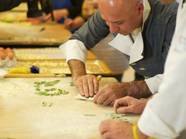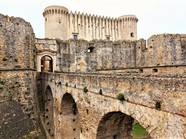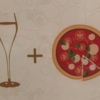Amarone: A Unique Wine
It was a cold morning in February as I headed to Felidia restaurant for the Wine Media Guild’s Amarone tasting and lunch. What better wines to taste and drink on a cold day and who better to speak about then Sandro Boscaini of the Masi winery? There were 30 wines to taste arranged by producer, so that we could better understand the different styles.
Amarone, began Sandro, is made from three Veronese grape varieties: Corvina is the most important because during appassimento it is subject to Botrytis (Noble Rot), which produces high levels of glycerin and glycolic acid. This, however, limits its ability to provide color and tannin. Rondinella is the second most important grape variety and a perfect compliment to Corvina. Its thick dark skin is very resistant to botrytis during the appassimento period and it adds color, tannins and aromas. Molinara, a light red grape, provides the acidity and drinkability that is unusual for a wine of this structure.
Appassimento: The drying of the grapes. The grapes are laid on straw racks for 80-to-100 days to dry, according to the vintage.
The drying is now done in temperature controlled warehouses. During the appassimento the grapes lose 30-40% of their weight due to evaporation and become semi-dried. They have sugar levels of between 25 and 28 Brix. Sandro Boscaini wants botrytis to attack his grapes. He feels it gives his wine a little added character. Other winemakers feel that drying the grapes is enough and the sweetness should be saved for the Recioto.
Recioto della Valpolicella is the sweet version of amarone made from semi-dried (appassito) grapes. Recioto comes from the local dialect “recie”, ears. Grape bunches have two small clusters branching out near the top. These “ears” are the choice part of the bunch because they stick out and get the most sun.
Amarone della Valpolicella is the dry wine version made from semi-dried (appassito) grapes when the wine is fully fermented. During vinification, if fermentation stops either naturally or by human intervention, the wine is left with residual sugar and is called Recioto.
If fermentation continues until the wine is completely dry, then the wine is called Amarone (from amaro, bitter).
Sandro pointed that until a few years ago there was great confusion between the two. Recioto della Valpolicella was the sweet and Recioto della Valpolicella Amarone was the dry. Now Recioto is only used on the label for the sweet version.
Amarone, said Sandro, is extremely concentrated, high in alcohol, deeply coloured and complex, and achieves a precise balance between all of its components. It is a velvety wine which is never excessively tannic or acidic. For this reason, it is appealing when relatively young; although it improves with ageing, and can continue to improve for many years. Due to its nobility, balance and power, it is considered a truly “majestic” wine.
Amarone has gained a new popularity over the last few years. This new popularity has led to Amarone being made outside the classical zone and to over-production. Sandro went on to say that regular Valpolicella is in danger of disappearing. (Franco Ziliani has an excellent article on Vinowire 01/26; Quantitly or Quality- Amarone Production Growing at an Alarming Rate ).
Sandro pointed to the 1964, 1983, 1990, 1995, 1997, 1988 and 2006
as the greatest vintages for Amarone
The wines
The first producer we tasted was Masi. There were eight of Sandro’s wines at the tasting. All of them showed very well and all were similar in character. He has moved to a more modern style and likes to keep a hint of Recioto in his Amarone. Figs, chocolate, cherries and dried prunes ran trough his wines. The Costasera Classico 2005 ($65) was the most modern in style and according to Sandro ready to drink. I found it to have a lot of flavor but it was tannic and needed more time.
The Serego Alighieri Viao Classico 2001 ($83) is his most traditional Amarone. This estate was bought by the son of Dante Alighieri in 1353. (The famous poet from
The Mazzano 1997 ($240) had a lot of character but more subtle flavors. The Campolongo di Torbe Classico 1997 had that underlining chocolate aroma and flavor, with hints of bitter cherries and spice.
Bertani is a very traditional producer of Amarone. They still dry the grapes in the traditional manner and use large Slavonian oak casks for the wine. Their current release is the Classico 2001 ($140). This wine needs more time to develop. It was closed, tannic with underlining fruit flavors. I took an open bottle home with me and drank it two nights later. It was just starting to open up. The Classico 1980 ($250), was full and dry with aromas of red berries, spices and chocolate. The Classico 1972 ($365) was showing its age. I have had this vintage before and it was showing better. The wines from this producer in a good year will last for 40 years or more.
Tommasi is a traditional producer. The Classico 2004 ($70) had flavors and aromas of prunes with a hint of chocolate. The 2003 ($70) was a bigger wine with more body. This may be due to the fact that it was very warm in 2003. The Classico “Ca’Florian” 2001 ($52) was drinking well and seemed very developed. These wines work very well with food.
Fratelli Speri is also a traditional producer. There were three wines: the Monte Saint’Urbano 2004 ($87) 2003 ($75) and the 1994. It was interesting to taste 3 wines from the same vineyard in different years. The wines tasted more of raisins than of dried prunes with hints of spice and chocolate.
Tedeschi, Capitel Monte Oimi 2003 ($90). This was the wine that was closest to a Recioto, with very pronounced flavors, aromas and
oak that gave it vanilla undertones. This is not a food wine.
Some of the other wines that I liked were the La Salette “La Marega” 2004 ($75), Robert Mazzi & Figlia Classico Vigneto Castel 2004 ($77). This was a more modern style but the oak was well integrated and there were flavors and aromas of raisins. The Sartori Classico Corte Bra 1999 ($90) had hints of ripe red berries and plum.
Michele Castellani Amarone Classico was a producer that I had never tasted before. I was impressed by the Ca del Pipa, Colle Cristi 2004 ($65) , I Castel-Campo Casalin 2003 ($75) and the Ca del Pipa, Monte Cristi 1998. These wines were somewhere between modern and traditional, with hints of raisins, chocolate and spice but very well balanced.





































i-Italy
Facebook
Google+
This work may not be reproduced, in whole or in part, without prior written permission.
Questo lavoro non può essere riprodotto, in tutto o in parte, senza permesso scritto.